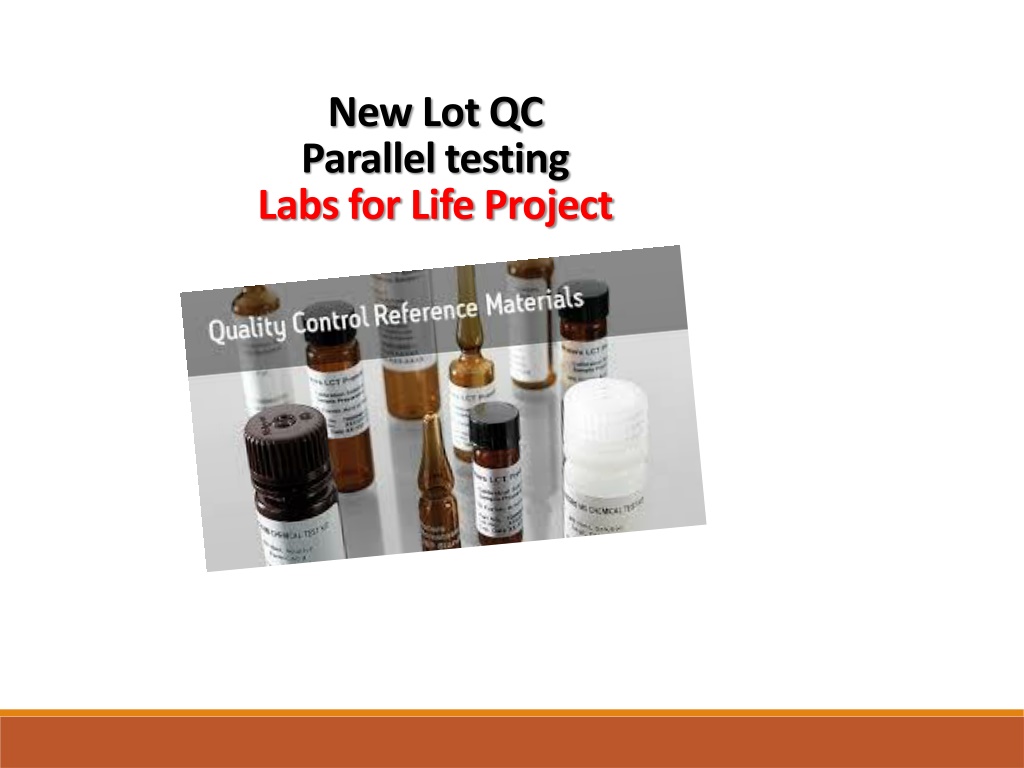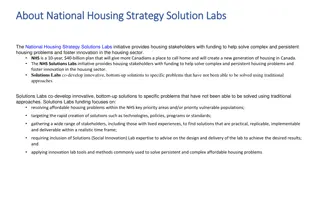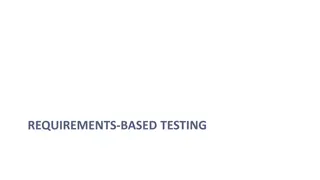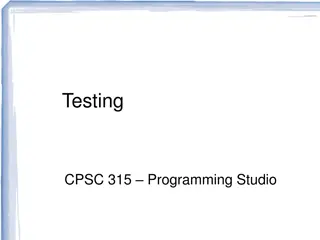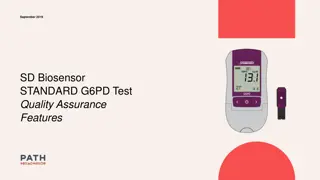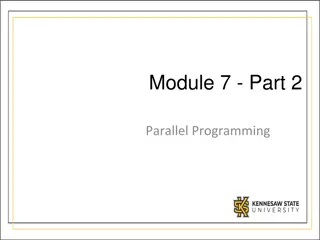Implementing Parallel Testing Labs for Quality Control in Life Science Projects
Implementing parallel testing labs for quality control in life science projects involves creating new LJ charts, utilizing the right control charts, understanding how Statistical Quality Control (SQC) works, evaluating QC with a stable analytical system, and conducting parallel testing to ensure the stability and accuracy of QC materials. This process aims to verify manufacturer-stated means and standard deviations, maintain system stability, and collect data points for monitoring and reporting patient results.
Download Presentation

Please find below an Image/Link to download the presentation.
The content on the website is provided AS IS for your information and personal use only. It may not be sold, licensed, or shared on other websites without obtaining consent from the author. Download presentation by click this link. If you encounter any issues during the download, it is possible that the publisher has removed the file from their server.
E N D
Presentation Transcript
New Lot QC Parallel testing Labs for Life Project
When Do You Create a New LJ Chart? a. QC Lot changes b. Major component change on the instrument c. Change in the testing process, usually manufacturer-directed. 2 2
Having the Right Control Chart Having the Right Control Chart Detects measurement errors with: Detects measurement errors with: Minimum false accepts (an outlier accepted Minimum false accepts (an outlier accepted because the chart did not flag it as an outlier) because the chart did not flag it as an outlier) Minimum false rejections (a valid run rejected Minimum false rejections (a valid run rejected because the chart flagged it as an outlier) because the chart flagged it as an outlier)
How SQC Works SD obs MEAN obs We did expect this point We did NOT expect this point(s) We compare today s observed value with the past history of previous results past history of previous results to determine if the system is stable or undergoing a change.
Overview: Introducing a New Lot Number into Service +2 SD +1 SD MEAN obs SD obs Assigned MEAN -1 SD -2 SD To obtain data to calculate the mean and SD In parallel with the lot number currently in-use
Evaluate your QC with a stable analytical system before your QC can evaluate your analytical system for instability! True Democracy!
Under evaluation! Stable Analytical System Using QC to Monitor Analytical System 7 10/5/2024 QC TRAINING - LABS FOR LIFE PROJECT
Why Parallel testing? 1. Collecting data of the New Lot QC material In Parallel With The Currently (In-use)Lot of QC 2. Manufacturer stated mean and SD are to be verified before the QC material is used for patient reporting 3. System Should be Stable 4. Old/ running lot is run to assure that the system is stable A. For patient results reporting B. For validating the data from new lot 5. New Lot: To collect history (data points). A mean and an SD to use the new lot for monitoring the system 6. Parallel testing is performed whether the control is assayed or un- assayed
How? Ideally a minimum of at least 20 measurements20 (to know inherent variability of the system) is ideal, to be done on separate days when the measurement system is known to be stable( based on QC results from existing lots) Establish the Mean and SD and transport to a new LJ chart Once verified and values are confidently assigned, the QC can be now used to monitor your analytical system s performance
An alternative : What if lab does not have the An alternative : What if lab does not have the time or the resources for 20 parallel runs? time or the resources for 20 parallel runs? Using the analyte s old %CV and the new mean of 4-5 runs 1. Get 4-5 values of the new QC 2. Find the Mean and 3. Derive the SD by using the formula 4. SD = CV (from old lot) * Mean (from new lot) 5. Apply on the new control chart Ensure that the System is stable Mean not drifting
Why use the mean the mean from 4-5 runs and not the SD of those runs? An SD means dispersion to capture the variables of the lab Lab variables can be captured by the too few runs 4-5 runs SD will be too narrow, too unrealistic, will rise to false alerts. Hence using this CV on a reasonably accurate mean of 4-5 runs will alert you to both inaccuracy and imprecision with minimum false alerts The initial standard deviation value obtained by the calculation may be replaced with a more robust estimate when data from a longer period of stable operation become available
Again, why use the CV from before but not the SD? Again, why use the CV from before but not the SD? SD is too dependant on the mean as it is an absolute value. SD can change with concentration of the analyte, i.e the mean Using the % equalizer, the CV, will eliminate this
Some checkpoints: Sampling from at least a few reconstituted vials will include any errors of reconstitution and capture more lab variables for a more robust mean and realistic SD For liquid stable quality control products, fewer bottles may be required, since such materials are expected to exhibit less vial to vial variation When an opened bottle of QC material will be used for more than one day, the same bottle should be assayed on several days to allow analyte stability to be reflected in the mean value
Recommendation for parallel testing: NABL 112 CBC and coagulation: Run new QC 4-6 data points in 2 days(depending on stability) Clinical chemistry: 2-3 time a day for 2-10 days for at least 20 data points Qualitative and semi-quantitative: At least 3 patient samples (neg, low pos, high pos) should be run along with old and new lot
Summary steps of parallel testing Summary steps of parallel testing Step 1: Using the package insert information: Set the initial control limits, usually a 2 SD range, for the new lot # of control. Use this range as a guideline only to ensure that the control material is acceptable (shipped and stored correctly) Step 2: For each day of parallel testing: Test current lot number of instrument/method is performing within quality specifications. Analyze the new control material and ensure that the data point falls between the 2 SD range. Handle the new lot number material in the same manner to encompass the normal day-to-day sources of variability (inherent randomness) routinely encountered, such as: control to confirm that the
Summary steps of parallel testing Step 3: Serial testing of new lot number of control material Collect a minimum of 20 data points from the new lot number Preferably over a 20 day period If a shorter time frame: collect 20 data points over a 10 day period by analyzing the new lot number twice a day Record data points and keep instrument printouts if applicable Step 4:Calculate your observed mean and SD for the new lot number Step 5: Calculate your control limits ( 1 SD, 2 SD, 3 SD, and 4 SD) Step 6: Create your L-J chart Step 7: When your current lot number expires or is consumed, Replace the L-J charts with the new-to-be current charts Retain the old charts according to your record retention schedule
